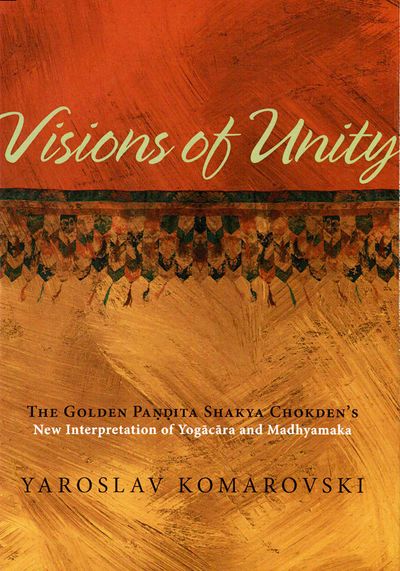|
|
| Line 21: |
Line 21: |
| **{{i|1. Political and Religious Landscape of Fifteenth-Century Tibet |17 }} | | **{{i|1. Political and Religious Landscape of Fifteenth-Century Tibet |17 }} |
| **{{i|2. Life of the Golden Paṇḍita |23 }} | | **{{i|2. Life of the Golden Paṇḍita |23 }} |
| ***{{i|Early Years and Education |25 }} | | ***{{i|''Early Years and Education'' |25 }} |
| ***{{i|Becoming a Prolific Writer and Famous Scholar |31 }} | | ***{{i|''Becoming a Prolific Writer and Famous Scholar'' |31 }} |
| ***{{i|Settling in the Golden Monastery and Exploring New Horizons |35 }} | | ***{{i|''Settling in the Golden Monastery and Exploring New Horizons'' |35 }} |
| ***{{i|Becoming a Tantric Master and Crystallizing Novel Views |44 }} | | ***{{i|''Becoming a Tantric Master and Crystallizing Novel Views'' |44 }} |
| **{{i|3. Writings of Shakya Chokden| 51 }} | | **{{i|3. Writings of Shakya Chokden| 51 }} |
| ***{{i|Chronological List of Shakya Chokden's Works| 51 }} | | ***{{i|''Chronological List of Shakya Chokden's Works''| 51 }} |
| ***{{i|Topical Divisions of Shakya Chokden's Works Addressed in This Book |59 }} | | ***{{i|''Topical Divisions of Shakya Chokden's Works Addressed in This Book'' |59 }} |
| | |
| *{{i|Chapter Two: The Intellectual Background of Shakya Chokden's Interpretation of Yogācāra and Madhyamaka |71 }} | | *{{i|Chapter Two: The Intellectual Background of Shakya Chokden's Interpretation of Yogācāra and Madhyamaka |71 }} |
| **{{i|1. Two Tendencies in Yogācāra and Niḥsvabhāvavāda Writings |71 }} | | **{{i|1. Two Tendencies in Yogācāra and Niḥsvabhāvavāda Writings |71 }} |
| Line 33: |
Line 34: |
| **{{i|3. Pointed Disappointments: Shakya Chokden's Personal Reflections |91 }} | | **{{i|3. Pointed Disappointments: Shakya Chokden's Personal Reflections |91 }} |
| **{{i|4. Broadening Empty Horizons: A Note on Changes in Shakya Chokden's<br>Views |102 }} | | **{{i|4. Broadening Empty Horizons: A Note on Changes in Shakya Chokden's<br>Views |102 }} |
| | |
| *{{i|Chapter Three: Readjusting Rungs of the Ladder: Revisiting Doxographical Hierarchies| 109 }} | | *{{i|Chapter Three: Readjusting Rungs of the Ladder: Revisiting Doxographical Hierarchies| 109 }} |
| **{{i|1. Key Features of Shakya Chokden's Approach to the Buddhist Tenets |109 }} | | **{{i|1. Key Features of Shakya Chokden's Approach to the Buddhist Tenets |109 }} |
| **{{i|2. Demarcating the Middle: On the Valid Divisions of Madhyamaka and Great Madhyamaka |116 }} | | **{{i|2. Demarcating the Middle: On the Valid Divisions of Madhyamaka and Great Madhyamaka |116 }} |
| **{{i|3. Self-Emptiness and Other-Emptiness |122 }} | | **{{i|3. Self-Emptiness and Other-Emptiness |122 }} |
| ***{{i|Self-Emptiness |124 }} | | ***{{i|''Self-Emptiness'' |124 }} |
| ***{{i|Other-Emptiness |127 }} | | ***{{i|''Other-Emptiness'' |127 }} |
| **{{i|4. Bidding Farewell to the Prāsaṅgika/Svātantrika Division? |136 }} | | **{{i|4. Bidding Farewell to the Prāsaṅgika/Svātantrika Division? |136 }} |
| **{{i|5. Are There Two Types of Yogācāra Madhyamaka? |141 }} | | **{{i|5. Are There Two Types of Yogācāra Madhyamaka? |141 }} |
| **{{i|6. Are There Any Cittamātra Followers Around? |145}} | | **{{i|6. Are There Any Cittamātra Followers Around? |145}} |
| **{{i|7. Expanding the Madhyamika Camp |150}} | | **{{i|7. Expanding the Madhyamika Camp |150}} |
| | |
| *{{i|Chapter Four: Through Broken Boundaries to New Enclosures: Reconciling<br>Yogācāra and Madhyamaka |157}} | | *{{i|Chapter Four: Through Broken Boundaries to New Enclosures: Reconciling<br>Yogācāra and Madhyamaka |157}} |
| **{{i|1. Differences between Alīkākāravāda and Satyākāravāda |157}} | | **{{i|1. Differences between Alīkākāravāda and Satyākāravāda |157}} |
| **{{i|2. The Heart of the Matter: Probing the Alīkākāravāda/ Niḥsvabhāvavāda Distinction |168}} | | **{{i|2. The Heart of the Matter: Probing the Alīkākāravāda/ Niḥsvabhāvavāda Distinction |168}} |
| **{{i|3. A New Look at the Old Origins: Distinctions of Madhyamaka Stemming<br>from Interpretations of the Second and Third Dharmacakras |183}} | | **{{i|3. A New Look at the Old Origins: Distinctions of Madhyamaka Stemming<br>from Interpretations of the Second and Third Dharmacakras |183}} |
| ***{{i|Looking at the Second and Third Dharmacakras through the Eyes of the Madhyamaka Founders |183}} | | ***{{i|''Looking at the Second and Third Dharmacakras through the Eyes of the Madhyamaka Founders'' |183}} |
| ***{{i|Position of Alīkākāravāda |186}} | | ***{{i|''Position of Alīkākāravāda'' |186}} |
| ***{{i|Position of Niḥsvabhāvavāda |191}} | | ***{{i|''Position of Niḥsvabhāvavāda'' |191}} |
| ***{{i|Positions of Later Madhyamikas |201}} | | ***{{i|''Positions of Later Madhyamikas'' |201}} |
| **{{i|4. Steering the Middle Way between the Two Conflicting Middle Ways:<br>The Art of Not Taking Sides |207}} | | **{{i|4. Steering the Middle Way between the Two Conflicting Middle Ways:<br>The Art of Not Taking Sides |207}} |
| | |
| *{{i|Chapter Five: Explorations in Empty Luminosity: Shakya Chokden's Position on Primordial Mind |213}} | | *{{i|Chapter Five: Explorations in Empty Luminosity: Shakya Chokden's Position on Primordial Mind |213}} |
| ***{{i|1. Facing the Reality of Primordial Mind |213}} | | ***{{i|1. Facing the Reality of Primordial Mind |213}} |
| ***{{i|Primordial Mind and the Question of Existence |213}} | | ***{{i|''Primordial Mind and the Question of Existence'' |213}} |
| ***{{i|The Question of Withstanding Analysis |220}} | | ***{{i|''The Question of Withstanding Analysis'' |220}} |
| ***{{i|Does True Existence Have to Be Negated in Order to Abandon Grasping at It? |223}} | | ***{{i|''Does True Existence Have to Be Negated in Order to Abandon Grasping at It?'' |223}} |
| **{{i|2. Primordial Mind as an Impermanent Phenomenon |228}} | | **{{i|2. Primordial Mind as an Impermanent Phenomenon |228}} |
| **{{i|3. (Un)linking the Self-Cognizing Primordial Mind and Dualistic Consciousness |238}} | | **{{i|3. (Un)linking the Self-Cognizing Primordial Mind and Dualistic Consciousness |238}} |
| **{{i|4. Does Self-Cognition Cognize Itself? |242}} | | **{{i|4. Does Self-Cognition Cognize Itself? |242}} |
| **{{i|5. Primordial Mind as the Bridge between Yogācāra and Tantra |249}} | | **{{i|5. Primordial Mind as the Bridge between Yogācāra and Tantra |249}} |
| ***{{i|Primordial Mind as the Focus of All Mahāyāna Paths |249}} | | ***{{i|''Primordial Mind as the Focus of All Mahāyāna Paths'' |249}} |
| ***{{i|Different but Concordant Approaches to Primordial Mind in Alīkākāravāda and Tantra |252}} | | ***{{i|''Different but Concordant Approaches to Primordial Mind in Alīkākāravāda and Tantra'' |252}} |
| ***{{i|A Powerful Ally: Using the Tantric View of Reality for Support |264 }} | | ***{{i|''A Powerful Ally: Using the Tantric View of Reality for Support'' |264 }} |
| *{{i|Conclusion: The Grand Unity—Shakya Chokden's Middle Way |269 }} | | |
| *{{i|Glossary of Buddhist Terms: English-Tibetan with Sanskrit Parallels |279 }} | | *{{i|Conclusion: The Grand Unity—Shakya Chokden's Middle Way |269}} |
| *{{i|Spellings of Tibetan Names and Terms |299 }} | | |
| *{{i|Notes |307 }} | | *{{i|Glossary of Buddhist Terms: English-Tibetan with Sanskrit Parallels|279}} |
| *{{i|Bibliography |391 }} | | |
| *{{i|Index |423}} | | *{{i|Spellings of Tibetan Names and Terms|299}} |
| | |
| | *{{i|Notes|307}} |
| | |
| | *{{i|Bibliography|391}} |
| | |
| | *{{i|Index|423}} |
| |AddRelatedTab=No | | |AddRelatedTab=No |
| |PostStatus=Needs Final Review | | |PostStatus=Needs Final Review |


